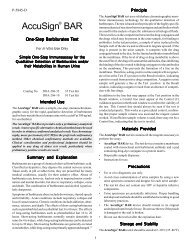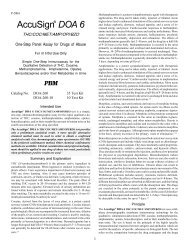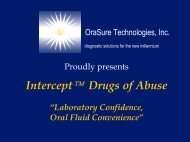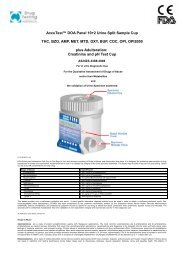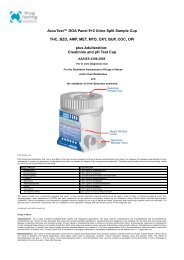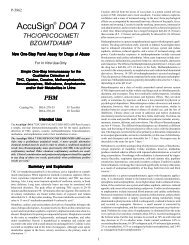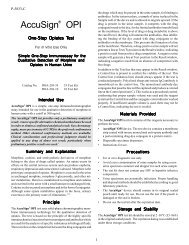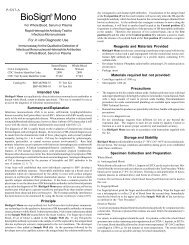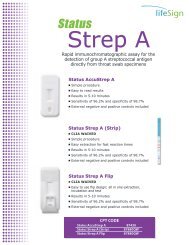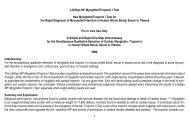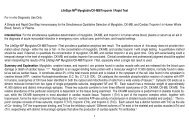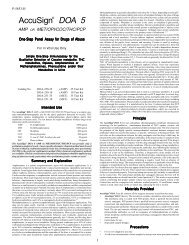Create successful ePaper yourself
Turn your PDF publications into a flip-book with our unique Google optimized e-Paper software.
OraSure Technologies, Inc.<br />
150 Webster Street, Bethlehem, PA 18015-1389<br />
Phone: 610-882-1820 • 1-800-869-3538 (USA) • Fax: 610-882-1830<br />
www.orasure.com<br />
<strong>OPI</strong>ATES INTERCEPT MICRO-PLATE EIA<br />
for use with <strong>Intercept</strong> <strong>Drug</strong>s of Abuse (DOA) Oral Fluid Specimens<br />
14051 - 1<br />
14051 (01/02)<br />
INTENDED USE<br />
The OraSure Technologies, Inc. (OTI) Opiates <strong>Intercept</strong> MICRO-PLATE EIA is intended for use in the<br />
qualitative determination of opiates in oral fluid collected with the <strong>Intercept</strong> DOA Oral Specimen Collection<br />
Device. THIS TEST IS INTENDED FOR IN VITRO DIAGNOSTIC USE.<br />
The OTI Opiates <strong>Intercept</strong> MICRO-PLATE EIA provides only a preliminary analytical test result.<br />
A more specific alternative chemical method should be used in order to obtain a confirmed analytical<br />
result. Gas chromatography/mass spectrometry (GC/MS) is the preferred confirmatory method. (1)<br />
Clinical consideration and professional judgment should be applied to any drugs of abuse test result,<br />
particularly when a preliminary, positive result is observed.<br />
BACKGROUND<br />
Opiates appear in saliva within one hour after use and, depending upon dose and rate of saliva flow, may<br />
persist in saliva for as long as 24 hours. (2,3) Upon heroin administration, the major species detected in saliva<br />
is morphine and in urine it is conjuga ted morphine. However, morphine, codeine, and hydromorphone<br />
have been detected in saliva following administration. (2,3) Heroin doses of 5 and 10 mg have been detected<br />
by immunoassay with high probability for 1 to 2 hours in saliva, while lower doses were not consistently<br />
detected at any sampling time. (3) Conversely, 10 mg morphine is detectable in urine for up to 6 days after<br />
use, with the concentration approaching the NIDA cutoff of 300 ng/mL within about 36 hours. (2)<br />
The OTI Opiates <strong>Intercept</strong> MICRO-PLATE EIA detects opiates including morphine, codeine,<br />
diacetylmorphine, hydrocodone, and hydromorphone.<br />
PRINCIPLE OF THE ASSAY<br />
The OTI Opiates <strong>Intercept</strong> MICRO-PLATE EIA is a competitive micro-plate immunoassay for the detection<br />
of opiates in oral fluid collected with the <strong>Intercept</strong> DOA Oral Specimen Collection Device. Specimen or<br />
standard is added to an EIA well in combination with an enzyme-labeled hapten derivative. In an EIA well<br />
containing an oral fluid specimen positive for opiates, there is a competition between the drug and the<br />
enzyme-labeled hapten to bind the antibody fixed onto the EIA well. EIA wells are then washed, substrate is<br />
added, and color is produced. The absorbance measured for each well at 450 nm is inversely proportional to<br />
the amount of opiates present in the specimen or calibrator/control. Because currently there are no SAMHSA<br />
assigned cutoffs for opiates testing using oral fluid, OTI recommends a cutoff of 10 ng/mL when testing oral<br />
fluid collected with the <strong>Intercept</strong> DOA Oral Specimen Collection Device. This cutoff is within the limit of<br />
detection by the OTI Opiates <strong>Intercept</strong> MICRO-PLATE EIA.<br />
PRINCIPLE OF THE INTERCEPT DOA ORAL SPECIMEN COLLECTION DEVICE<br />
Saliva is a complex mixture of parotid, submandibular, sublingual and minor salivary gland secretions mixed<br />
with mucin, bacteria, leukocytes, sloughed epithelial cells and gingival crevicular fluid. The fact that opiates<br />
are present in oral fluid following human use is well documented. (2)<br />
The <strong>Intercept</strong> DOA Oral Specimen Collection Device was developed for the purpose of collecting oral fluid<br />
for diagnostic testing. The collection device consists of a treated absorbent cotton fiber pad affixed to a nylon<br />
stick (Collection Pad) and a preservative solution in a plastic container (Specimen Vial). The Collection Pad is<br />
impregnated with a mixture of common salts and gelatin which creates a hypertonic environment and an<br />
increased osmotic pressure wherever it contacts oral mucosal cells. The pad is placed in contact with the
gingival mucosa (between the lower gum and cheek) which enhances the flow of mucosal transudate across<br />
the mucosal surfaces onto the absorptive cotton fibers of the pad. Following the collection period, the<br />
Collection Pad is placed into a vial containing a preservative solution which serves to inhibit the growth of<br />
oral micro-organisms recovered on the Collection Pad. The vial is sealed with a plastic cap and transported to<br />
a laboratory for processing and testing. Following processing, a fluid containing a mixture of saliva<br />
components and the preservative solution is recovered which is suitable for testing for the presence of<br />
opiates in the OTI Opiates <strong>Intercept</strong> MICRO-PLATE EIA manufactured by OraSure Technologies,<br />
Bethlehem, PA. Refer to the <strong>Intercept</strong> DOA Oral Specimen Collection Device product insert for specific<br />
instructions on the proper collection, handling, and adequacy of oral fluid samples.<br />
REAGENTS PROVIDED<br />
Catalog No.<br />
1150IB<br />
Catalog No.<br />
1150IC<br />
KIT COMPONENTS 480 Test Kit 9600 Test Kit<br />
Min. Qty. Min. Qty.<br />
Anti-Morphine Coated Plate -- Rabbit anti-morphine polyclonal<br />
5 100<br />
antibody immobilized on a polystyrene plate supplied in dry form.<br />
Enzyme Conjugate -- Horseradish peroxidase labeled with a morphine 60 mL 1 L<br />
hapten diluted in a protein matrix of bovine serum with protein<br />
stabilizers.<br />
Substrate Reagent -- One bottle containing 3,3', 5,5'<br />
60 mL 1 L<br />
tetramethylbenzidine.<br />
Stopping Reagent -- Each bottle contains 2 N sulfuric acid. 60 mL 1 L<br />
Oral Fluid Negative Calibrator – Oral Fluid Diluent negative for<br />
2 mL 16 mL<br />
morphine.<br />
Oral Fluid Negative Control – Oral Fluid Diluent containing 5 ng/mL 2 mL 16 mL<br />
(v/v) morphine.<br />
Oral Fluid Cutoff Calibrator – Oral Fluid Diluent containing 10<br />
2 mL 16 mL<br />
ng/mL (v/v) morphine.<br />
Oral Fluid Positive Control – Oral Fluid Diluent containing 20 ng/mL<br />
(v/v) morphine.<br />
2 mL 16 mL<br />
WARNINGS AND PRECAUTIONS<br />
1. The handling of food or drink near the kit reagents is NOT recommended.<br />
2. Proper handling of all reagents is strongly advised. It is suggested that disposable materials are used to<br />
avoid contamination of Substrate Reagent. Discard Substrate Reagent if obvious blue color develops.<br />
3. Do NOT mouth pipet reagents. Handle all specimens and reagents as if potentially infectious.<br />
4. Do NOT add sodium azide to samples as a preservative!<br />
5. Keep all containers closed when not in use to avoid microbial contamination.<br />
6. Do NOT use reagents past the expiration date.<br />
7. Do NOT mix reagents from different kits or manufacturers.<br />
8. Do NOT freeze reagents.<br />
9. It is suggested that all OTI reagents be kept out of direct sunlight whenever possible.<br />
STORAGE/STABILITY OF THE OTI <strong>OPI</strong>ATES INTERCEPT MICRO-PLATE EIA<br />
Store all reagents at 2-8°C until the expiration date on the kit label.<br />
STORAGE/STABILITY OF THE INTERCEPT DOA ORAL SPECIMENS<br />
Oral fluid specimens may be stored at 4°C (39°F) to 37°C (98°F) for a maximum of 21 days. Specimens must<br />
be tested in the OTI Opiates <strong>Intercept</strong> MICRO-PLATE EIA no later than 21 days following specimen<br />
collection, assuming that they have been maintained between 4°C and 37°C prior to testing. Specimens may<br />
be stored in either the original specimen storage vial or may be maintained as a processed fluid while being<br />
stored in a separate storage tube.<br />
14051 - 2
INTERCEPT DOA SPECIMEN PROCESSING PROCEDURE<br />
MATERIALS REQUIRED BUT NOT PROVIDED<br />
1. Tubes suitable for centrifuging <strong>Intercept</strong> DOA Specimen Vials.<br />
2. Centrifuge capable of 600 - 800 x g.<br />
PROCEDURE (Refer to <strong>Intercept</strong> DOA Collector package insert for more information)<br />
1. Record the specimen identification number from the <strong>Intercept</strong> DOA Specimen Vial.<br />
2. Ensure that the specimen is within acceptable dating for testing, i.e. ≤ 21 days from the time of collection.<br />
3. Hold the vial upright with the tip pointed up.<br />
4. Move the pad away from the vial tip by gently tapping the vial.<br />
5. Break the pointed tip of the vial off with your thumb.<br />
6. Place a tube over the vial and invert the tube and vial.<br />
7. Centrifuge at 600 - 800 x g for 15 minutes.<br />
8. Assay or store the resulting eluate according to the procedures described herein.<br />
9. A minimum of 0.7 mL of the eluate sample is required. This can be determined by centrifugation of the<br />
samples into graduated containers or by direct pipetting with a calibrated pipet adjusted to the specified<br />
volume.<br />
10. If the minimum volume requirement is not met, a new sample should be collected. If this is not possible,<br />
a warning should accompany any data generated indicating that an insufficient amount of sample was<br />
collected and that this may affect the accuracy of the final result.<br />
ASSAY PROCEDURE<br />
MATERIALS REQUIRED BUT NOT PROVIDED<br />
1. Semi-automated pipets (25, 50 and 100 microliters) with tips.<br />
2. Micro-plate reader capable of reading at a dual wavelength of 450 and 630 nm.<br />
3. Micro-plate washer.<br />
4. <strong>Intercept</strong> DOA eluate sample(s) - 0.7 mL minimum.<br />
PROCEDURE -- Note: Allow all reagents and samples to come to room temperature (15-27 C) before use.<br />
1. At the discretion of the operator, all samples, calibrators, and controls may be tested in duplicate. The<br />
inclusion of calibrators and controls is recommended in each run.<br />
2. Add 25 microliters of sample, calibrator, or control to each well. Label wells appropriately.<br />
3. Add 100 microliters of Enzyme Conjugate to each test well.<br />
4. Incubate for 30 minutes at room temperature (15-27°C) in the dark.<br />
5. Using a suitable plate washer, wash each well six (6) times with 300 microliters of distilled water.<br />
6. Add 100 microliters of Substrate Reagent to each well and incubate 30 minutes at room temperature (15-<br />
27°C) in the dark.<br />
7. Add 100 microliters of Stopping Reagent to each well.<br />
8. Measure the absorbance at a dual wavelength of 450 nm and 630 nm within 15 minutes of stopping the<br />
reaction.<br />
INTERPRETATION<br />
Positive result:<br />
Any sample with an absorbance less than or equal to the Oral Fluid Cutoff Calibrator is<br />
considered a positive.<br />
Negative result: Any sample with an absorbance greater than the Oral Fluid Cutoff Calibrator is considered<br />
a negative.<br />
When interpreting duplicate results, the operator must be aware of several factors which may influence assay<br />
results. These include precise pipetting of specimens and reagents, effective washing of plates, and properly<br />
calibrated and maintained instrumentation. It is recommended that duplicate sample results which differ by<br />
more than 10% be retested. In addition, final pH levels of an oral fluid sample ≤ 5.0 may produce false<br />
positive results in the assay.<br />
14051 - 3
Also, negative patient results may indicate that either a patient specimen is negative for opiates, that the<br />
specimen contains less than 10 ng/mL opiates, or that an insufficient sample was collected.<br />
QUALITY CONTROL<br />
OTI provides negative and positive controls to monitor the daily performance of the OTI Opiates <strong>Intercept</strong><br />
MICRO-PLATE EIA. The Oral Fluid Negative Control must have an absorbance greater than the Oral Fluid<br />
Cutoff Calibrator, while the Oral Fluid Positive Control must have an absorbance less than the Oral Fluid<br />
Cutoff Calibrator.<br />
LIMITATIONS OF THE PROCEDURE<br />
The assay is designed for use with oral fluid collected with the <strong>Intercept</strong> DOA Oral Specimen Collection<br />
Device. Other samples may produce variable results, and their use is not recommended.<br />
SPECIFIC PERFORMANCE CHARACTERISTICS OF INTERCEPT DOA SPECIMENS<br />
Analytical Sensitivity/Limit Of Detection - The Limit of Detection (LOD) was defined from the signal-tonoise<br />
ratio at the zero-drug concentration as the mean zero absorbance (A0) minus the noise times three<br />
(LOD = A0 - 3SD). The LOD was determined by obtaining the absorbance value for blank oral fluid devices<br />
and calculating the standard deviation (SD) of the absorbance values. The absorbance value minus 3SD<br />
was then extrapolated from the curve and represents the sensitivity of the assay. The LOD was calculated<br />
to be 1.4 ng/mL.<br />
Precision - The precision of the OTI Opiates <strong>Intercept</strong> MICRO-PLATE EIA was assessed by testing Control<br />
Matrix containing 0, 5, 10, or 20 ng/mL morphine over a 5-day period. The intra-assay precision was<br />
calculated using 20 replicates of data from the first day. Inter-assay precision was calculated for the entire 5<br />
days. The results of this testing are described in the following table:<br />
MORPHINE<br />
(ng/mL)<br />
INTRA-ASSAY<br />
% CV (n=20)<br />
14051 - 4<br />
INTER-ASSAY<br />
% CV (n=20/day, 5 days)<br />
0 3.6 7.5<br />
5 6.4 8.9<br />
10 6.6 9.5<br />
20 6.9 8.7<br />
Analytical Specificity/Cross-Reactivity - The analytical specificity of an immunoassay is defined as the<br />
cross-reactivity of substances in the assay which are structurally related to the target compound. The<br />
percent cross-reactivity of a compound in the OTI Opiates <strong>Intercept</strong> MICRO-PLATE EIA is defined as<br />
the apparent morphine concentration divided by the spiked concentration times 100.<br />
The cross-reactivity of structurally related compounds was calculated at several spiked concentrations in<br />
Control Matrix. The following table indicates the apparent concentration of morphine for each substance<br />
at a concentration which cross-reacted in the assay.<br />
The following compounds cross-react in the assay at the levels shown:<br />
Compound Tested Concentration<br />
(ng/mL)<br />
Morphine Equivalents<br />
(ng/mL)<br />
Cross-Reactivity<br />
(%)<br />
6-Acetylmorphine 25 16 65<br />
Codeine 1 4 >100<br />
Dextromethorphan 10000 5 0.05<br />
Diacetylmorphine 25 11 43<br />
Dihydrocodeine 10 18.5 185<br />
Hydrocodone 25 19 76<br />
Hydromorphone 100 20 20<br />
Levorphanol 1000 19 2<br />
Meperidi ne 10000 8 0.08<br />
Morphine 10 10 100<br />
Morphine-3-β-<br />
Glucuronide<br />
1000 19 2
Nalorphine 10000 16 0.16<br />
Normorphine 1000 9 0.85<br />
Oxycodone 1000 10 1.0<br />
Oxymorphone 10000 10 0.10<br />
The following compounds were spiked into Control Matrix at a target concentration of 10,000 ng/mL and<br />
tested for cross-reactivity. None were found to produce a signal less than or equal to that of the Cutoff<br />
Calibrator.<br />
4-Aminophenyl Sulfone<br />
Acetylsalicylic Acid<br />
Alprazolam<br />
Amobarbital<br />
Ampicillin<br />
Atropine<br />
β-Phenethylamine<br />
Benzoylecgonine<br />
Butabarbital<br />
Butalbital<br />
Caffeine<br />
Chlordiazepoxide<br />
Chlorpromazine<br />
Clonazepam<br />
Clorazepate<br />
Cocaethylene<br />
Cocaine<br />
Cotinine<br />
Cyclizine<br />
D-Amphetamine<br />
D-Methamphetamine<br />
Diphenhydramine<br />
Fenoprofen<br />
Fluoxetine<br />
Gemfibrozil<br />
Gentisic Acid<br />
Glipizide<br />
Ibuprofen<br />
Imipramine<br />
L-Ephedrine<br />
L-Methamphetamine<br />
Lidocaine<br />
Loperamide<br />
Medazepam<br />
Methadone<br />
Metoprolol<br />
Naproxen<br />
Niacinamide<br />
Norchlordiazepoxide<br />
Nordiazepam<br />
Nystatin<br />
PCP<br />
Penicillin<br />
Pentobarbital<br />
Phenobarbital<br />
Phenylephrine<br />
Phenylpropanolamine<br />
Procainamide<br />
Procaine<br />
Pseudoephedrine<br />
Quinidine<br />
Salbutamol<br />
Temazepam<br />
Tolmetin<br />
∆ 9 -THC<br />
Theophylline<br />
Zomepirac<br />
It is possible that other substances and/or factors not listed above may interfere with the test and cause<br />
false results, e.g., technical or procedural errors.<br />
ACCURACY<br />
The clinical sensitivity and specificity of the OTI MICRO-PLATE assay were determined by testing<br />
specimens from chronic opiate users. A controlled dose study was also conducted to determine a minimum<br />
dose to produce a positive response in the OTI EIA. Both studies are described below. The cutoffs for EIA<br />
and GC/MS were 10 ng/mL and 15 ng/mL, respectively, for oral fluid specimens. For urine specimens, the<br />
EIA cutoff was 300 ng/mL and the GC/MS cutoff was 150 ng/mL (based on SAMHSA recommendations).<br />
Study 1 - Chronic Opiates Users<br />
Matched urine and oral fluid specimens were collected from ten (10) self-reported opiates users. An<br />
additional fifty (50) presumed negative samples were also included in the analysis. All sixty (60) samples<br />
were tested in the OTI Opiates <strong>Intercept</strong> MICRO-PLATE EIA and presumed positives (10) were also<br />
tested by gas chromatography/mass spectrometry (GC/MS). Results are presented in the following tables:<br />
Result Oral Fluid -<br />
OTI EIA*<br />
Oral Fluid -<br />
GC/MS*<br />
+ 3 2<br />
- 7 8<br />
*Of the 10 samples presumed positive, the % sensitivity and %<br />
specificity of the OTI EIA as compared to GC/MS were 100.0% and<br />
87.5%, respectively.<br />
Urine - OTI EIA<br />
(300 ng/mL Cutoff)<br />
+ -<br />
Oral Fluid - OTI EIA* + 3 0<br />
(10 ng/mL Cutoff) - 4 53<br />
% Relative Sensitivity = 42.9% % Relative Specificity = 100.0%<br />
14051 - 5
Result Urine -<br />
OTI EIA<br />
Urine -<br />
GC/MS**<br />
+ 7 8<br />
- 3 2<br />
**Of the 10 samples presumed positive, the % sensitivity and %<br />
specificity of the urine OTI EIA as compared to GC/MS were 87.5%<br />
and 100.0% respectively.<br />
It is believed that the poor agreement between the OTI Opiates <strong>Intercept</strong> MICRO-PLATE EIA and the<br />
OTI Opiates MICRO-PLATE EIA (urine) is driven by differences in the metabolism of heroin and<br />
partitioning in oral fluid and urine. Opiates generally appear later in urine and persist for up to 3-6 days. (2)<br />
Conversely, opiates in saliva is not detectable after 2-8 hours. (3) These differences do not diminish the<br />
clinical utility of either fluid. However, users should be aware of these differences.<br />
Study 2 - Controlled Dose Study<br />
A total of 5 volunteers in a controlled environment were administered an initial 3 mg of intravenous heroin<br />
HCl, followed by a second 6 mg or 12 mg heroin dose 4 to 12 days later. Saliva and urine samples were<br />
collected before dosing and periodically for up to 74 hours after dosing. Saliva specimens (400 µL) were<br />
added to the collection pad of the Oral Fluid Collection Device and processed according to the package<br />
insert. Samples were then tested using the OTI assay and GC/MS.<br />
Using a 10 ng/mL cutoff for oral fluid samples, opiates were detectable by EIA for up to 2 hours after a 12<br />
mg heroin dose and not detectable at any time for a 3 or 6 mg dose. Of the GC/MS saliva results, only the<br />
initial post-12 mg dose samples contained drug concentrations above the 15 ng/mL LOD/LOQ. This<br />
demonstrates the ability of the OTI EIA to detect opiate concentrations at intravenous doses as low as 12<br />
mg heroin HCl. The ability of the kit to detect opiates at doses between 6 mg-12 mg is unknown.<br />
REFERENCES<br />
1. "Urine <strong>Testing</strong> for <strong>Drug</strong>s of Abuse," National Institute on <strong>Drug</strong> Abuse (NIDA) Research Monograph 73,<br />
1986.<br />
2. Schramm, W., Smith, R.H., and Craig, P.A., "<strong>Drug</strong>s of Abuse in Saliva: A Review," Journal of Analytical<br />
Toxicology, 1992; 16:1-9.<br />
3. Cone, E., “<strong>Testing</strong> Human Hair for <strong>Drug</strong>s of Abuse. I. Individual Dose and Time Profiles of Morphine<br />
and Codeine in Plasma, Saliva, Urine, and Beard Compared to <strong>Drug</strong>-Induced Effects on Pupils and<br />
Behavior,” Journal of Analytical Toxicology, 1990; 14:1-7.<br />
4. Tenovuo, Jorma O., editor, Human Saliva: Clinical Chemistry and Microbiology, Volume 1 (CRC Press,<br />
Boca Raton, FL) 1989.<br />
5. <strong>Intercept</strong> Oral Specimen Collection Device, Package Insert. Manufactured by OraSure Technologies,<br />
Inc., Beaverton, OR 97008.<br />
Note: Adulteration of reagents, use of instruments without appropriate capabilities, or other failure to follow<br />
instructions as set forth in the labeling can affect performance characteristics and stated or implied label claims.<br />
***<br />
14051 - 6



